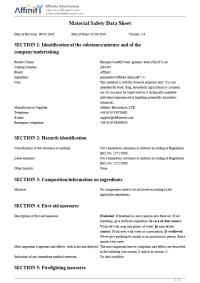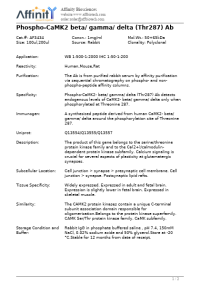Affinity Biosciences
AF3434
$280.00
100μl
| 100μl - | $280.00 | |
| 200μl - | $350.00 |
Phospho-CaMK2 beta/ gamma/ delta (Thr287) Antibody
 Western blot analysis of Phospho-CaMK2 beta/ gamma/ delta (Thr287) Antibody expression in rat...
Western blot analysis of Phospho-CaMK2 beta/ gamma/ delta (Thr287) Antibody expression in rat... AF3434 at 1/100 staining Mouse muscle tissue by IHC-P. The sample was formaldehyde fixed and a heat...
AF3434 at 1/100 staining Mouse muscle tissue by IHC-P. The sample was formaldehyde fixed and a heat... AF3434 at 1/100 staining human brain tissues sections by IHC-P. The tissue was formaldehyde fixed...
AF3434 at 1/100 staining human brain tissues sections by IHC-P. The tissue was formaldehyde fixed...Antigen:
Calcium/calmodulin-dependent protein kinase type II subunit beta
Synonyms: KCC2B_HUMAN; A4D2K0; A4D2K1; A4D2K2; A4D2K3; A4D2K4; A4D2K5; A4D2K6; O95437; O95438; O95599; Q13554; Q9UGH7; Q9UGH8; Q9UGH9; Q9UNX0; Q9UNX7; Q9UP00; Q9Y5N4; Q9Y6F4
Host:Rabbit
Reactivity:Human; Mouse; Rat
Application:Western Blotting; Immunohistochemistry; ELISA
Isotype:IgG
Clonality:Polyclonal
Aliases:Calcium/calmodulin-dependent protein kinase type II subunit alpha; Calcium/calmodulin-dependent protein kinase type II subunit delta; CaM kinase II subunit alpha; CaM kinase II subunit delta; CAM2; CaMK-II subunit alpha; CaMK-II subunit delta; CAMK2A; CAMK2B; CAMKA; CAMKB; CAMKD; CaMKII alpha; KIAA0968; CaM kinase II; CaM kinase II gamma chain; CaM kinase II subunit gamma; CAMK; CAMK II; CaMK II subunit gamma; CAMK2G; CAMKG; CAMKII; Calcium / calmodulin dependent protein kinase 2 delta; Calcium / calmodulin dependent protein kinase II delta; calcium/calmodulin-dependent protein kinase (CaM kinase) II delta; calcium/calmodulin-dependent protein kinase type II delta chain; Calcium/calmodulin-dependent protein kinase type II subunit delta; CAM kinase 2 delta; CAM kinase II delta; CaM kinase II delta subunit; CaM kinase II subunit delta; CaM-kinase II delta chain; CAMK 2d; CaMK-II delta subunit; CaMK-II subunit delta; CAMK2D; CAMKD; CAMKI; KCC2D_HUMAN; RATCAMKI
Description:
Calcium/calmodulin-dependent protein kinase that functions autonomously after Ca2+/calmodulin-binding and autophosphorylation, and is involved in dendritic spine and synapse formation, neuronal plasticity and regulation of sarcoplasmic reticulum Ca2+ transport in skeletal muscle. In neurons, plays an essential structural role in the reorganization of the actin cytoskeleton during plasticity by binding and bundling actin filaments in a kinase-independent manner. This structural function is required for correct targeting of CaMK2A, which acts downstream of NMDAR to promote dendritic spine and synapse formation and maintain synaptic plasticity which enables long-term potentiation (LTP) and hippocampus-dependent learning. In developing hippocampal neurons, promotes arborization of the dendritic tree and in mature neurons, promotes dendritic remodeling. Participates in the modulation of skeletal muscle function in response to exercise. In slow-twitch muscles, is involved in regulation of sarcoplasmic reticulum (SR) Ca2+ transport and in fast-twitch muscle participates in the control of Ca2+ release from the SR through phosphorylation of triadin, a ryanodine receptor-coupling factor, and phospholamban (PLN/PLB), an endogenous inhibitor of SERCA2A/ATP2A2.
Purification:The antibody is from purified?rabbit serum by affinity purification via sequential chromatography on phospho- and non-phospho-peptide affinity columns.
Concentration:1mg/ml
Buffer form:Liquid
Storage buffer:Rabbit IgG in phosphate buffered saline , pH 7.4, 150mM NaCl, 0.02% sodium azide and 50% glycerol.Store at -20 ¡ãC.Stable for 12 months from date of receipt
Specificity:
Phospho-CaMK2- beta/ gamma/ delta (Thr287) Antibody detects endogenous levels of CaMK2- beta/ gamma/ delta only when phosphorylated at Threonine 287.
Storage conditions:Rabbit IgG in phosphate buffered saline , pH 7.4, 150mM NaCl, 0.02% sodium azide and 50% glycerol.Store at -20 °C.Stable for 12 months from date of receipt.

Product specifications

Product specifications
Preparing document for printing...
0%

